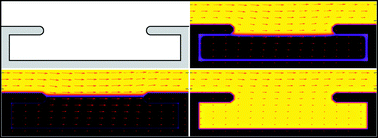Wetting and friction on superoleophobic surfaces†
Abstract
This article describes the physics of superoleophobic surfaces, combining a recently developed free-energy approach and finite element modeling. We start by investigating the peculiar wetting behavior of such surfaces, originating in their “re-entrant” geometry, and discussing a specific mechanism for the “filling transition”, leading to the loss of superoleophobicity. We then focus on their friction properties, and establish an important condition for their use as super-lubricating surfaces. This new insight into the underlying mechanisms of superoleophobicity enables us to suggest general principles to optimize the wetting and friction properties of those promising surfaces.


 Please wait while we load your content...
Please wait while we load your content...